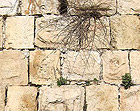|
|
Identifying the Problems and their Causes
4. Cracks
|

|
The survey identified three types of cracks in the wall:
Cracks caused by the roots of trees. This is the most common kind of crack in the wall. Tree roots exert internal pressure on the stones and cause movement that shifts them out of place and destroys the wall. Trees taking roots in the wall are likely to cause a dangerous situation resulting in the dismantling of stones and their falling out (Fig. 22).
In instances where trees have taken root in the wall it is recommended that they be extracted, that the roots are treated and that the cracks that were created are filled in. The most effective preventative treatment in this case is constant conservation maintenance.
/br>Cracks caused by rusting metal. The increase in the volume of metal parts, such as railings, handles etc, which rust causes, cracks in the wall (Fig. 23). The penetration of water via the cracks exacerbates the rusting of the metal parts and the cracking.
It is recommended that the existing metal anchor specifications be changed to include the use of rustproof metals in the development work; cracks should be filled in.
Cracks that are caused when the wall's outer facade is leaning. These cracks are typically in the corners and crenellations of the wall (Fig. 24). The cracks are parallel to the line of the facade. They are open on the upper part of the wall and closed c. 3 m below the top of the wall. The cracks are a maximum of c. 10 mm wide at the top of the wall. This cracking indicates the beginning of a destructive process that is occurring in the wall's structure.
The causes of this cracking are: water seeping into the wall; bonding material swelling in the core of the wall; bonding material that was washed from the core of the wall; the disintegration of the bonding material in the wall's outer surface and the deterioration in the facade's stability; the development of lateral forces exerted from the core outward to the outside of the wall.
It is recommended that the cracks be filled in with a lime-based bonding material and monitored and that conservation maintenance be implemented.
Identifying the Problems and their Causes > 5. Exposed core
|
|

|
| 21. Disintegration of bonding material |
|
 |
 |
|
|
| Websites, text and photos © Israel Antiquities Authority |
Powered by teti-tu |
|
|















